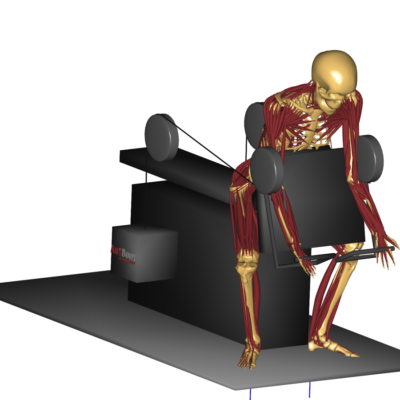Perform biomechanics research and sport equipment development through musculoskeletal modeling and simulation. Optimizing product performance is crucial when creating equipment for specific performance goals. The AnyBody Modeling System allows you to evaluate and improve equipment design through simulations of the human-body working in concert with its environments.
Examples:
- Product development
- Optimize product performance
- Import CAD models of sports equipment (STL)
- Evaluate and improve sports equipment design
- Human-machine interaction analysis
- Mechanics of sports equipment
- Autodesk: Include the human body in your product design with the AnyBody Modeling System (Download)

Tutorials
Case stories
- Autodesk: Include the human body in your product design with the AnyBody Modeling System (Download)
Models in AMMR
Selected papers
- Lace KL, Błażkiewicz M (2021), “How does the ski boot affect human gait and joint loading?“, Biomed. Hum. Kinet., vol. 13, pp. 163-169. [DOI, WWW]
- Bilde Simonsen M, Pessoto Hirata R, Næsborg-Andersen K, Derek Christian Leutscher P, Hørslev-Petersen K, Woodburn J, Skipper Andersen M (2021), “Different types of foot orthoses effect on gait mechanics in patients with rheumatoid arthritis“, J. Biomech., pp. 110496. [DOI,WWW]
- Lee H, Jung M, Lee KK, Lee SH (2017), “A 3D Human-Machine Integrated Design and Analysis Framework for Squat Exercises with a Smith Machine“, Sensors, vol. 17, pp. 299. [DOI]
- Kim T, Lee K, Kwon J (2012), “Design improvement of the smith machine using simulation on musculoskeletal model“, International Journal of CAD/CAM, vol. 12. [WWW]
- Jung M, Kim Y, Cho K, Lee K (2011), “A novel method to predict posture of human model chriwhen designing resistance training machines using musculoskeletal analysis“, In: Presented at the American Society of Biomechanics Meeting, Gainesville, FL, pp. 2-2 pp.. [PDF]
- Kwan MM, Rasmussen J (2011), “Linking Badminton Racket Design and Performance through Motion Capture“, CAME – Computer Aided Medical Engineering, vol. 1 , pp. 13-19. [PDF]